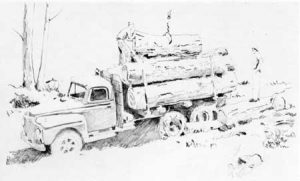WORLD WAR II PERIOD 1941-1945

World War II caused heavy inroads on the Nation's forests, as wood became a critical war material needed for barracks and cantonments, ships and docks, war plants and war housing, gun stocks,explosives, airplanes, boxes and crates for war supplies, and hundreds of other essential uses. The Armed Forces used a greater tonnage of wood than of steel. Many peace time activities were curtailed, such as the nationwide forest survey, reforestation work, and land acquisition under the Weeks law. The Forest Service, however, was called upon for numerous special war jobs; surveys of war requirements and supplies of forest products; an emergency rubber project for production of guayule and other rubber-bearing plants; a large-scale logging project in Alaska for production of urgently needed aircraft spruce; constant manning of lookout stations as part of the Army aircraft warning system; surveys of quinine, balsa, and other special forest-product resources in Latin America; emergency fire protection measures; numerous important studies and tests at the Forest Products Laboratory; and much other war work.
To help stimulate output of wood for war needs, a special Timber Production War Project was launched. This boosted lagging production and at the same time encouraged logging methods that left trees for future use and wasted as little as possible.
With so many men serving in the armed services,regular fire protection forces were severely depleted. The Office of Civilian Defense established a volunteer Forest Fire Fighters Service toaid Federal and State forestry agencies. Some 185,000 citizens enrolled.Conservation agencies cooperated in special fire prevention campaigns to make the public more aware of the great need for individual carefulness in fire prevention. The Japanese made numerous attempts to fire west coast forests with incendiary bombs carried by balloons, but were unsuccessful. Paratroopers and Army ground personnel were of great assistance in fighting fires.

Figure 21.—TV relay stations on the crest of the Sandia Mountains,Cibola National Forest, N. Mex. F—482905
Although winning the war was the most important objective, the cause of conservation was not entirely forgotten. Thedem and for more lumber showed the need for more forestry legislation.Some laws passed by the 78th Congress were:
Public Law 273 of March 29, 1944 (58 Stat. 132),authorized cooperative agreements for joint operation of public and private timber under sustained yield plans.
Public Law 296 of May 5,1944 (58 Stat. 216), amendedthe Clarke-McNary Act to authorize increased appropriations forcooperative fire protection.
Public Law 321 of May 31, 1944 (58 Stat. 265),authorized appropriations to keep forest surveys up to date.
Several States passed laws permitting the establishment of State, county, city, town, and school forests. Many States increased their appropriations for forestry and for fire protection.

Figure 22.—Recovering gold from a river bottom, Tahoe National Forest, Calif. F—503107

